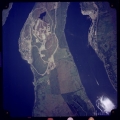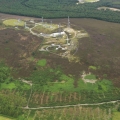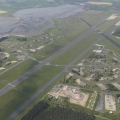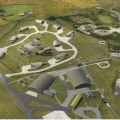The Cold War was a period of sustained political and military tension which existed between the western (USA and NATO) and eastern (Soviet Union and Warsaw Pact) powers from 1947-1991.
Scotland occupies a stategic position between continental Europe and the North Atlantic, and a variety of installations were built there during the Cold War by the UK and NATO. From submarine bases and airfields to military ports and nuclear bunkers, traces of Cold War construction can be seen across Scotland, and a selection of aerial images of these are examined in this Feature.
Nuclear Response
| Until 1968, the UK's nuclear deterrent was held by the Royal Air Force, which maintained a fleet of Valiant, Victor and Vulcan bombers at a state of constant readiness to deliver it. Several airfields in Europe and the Mediterranean were selected to serve, in times of national emergency, as dispersal sites for V-bombers armed with nuclear weapons. RAF Kinloss, Morayshire, was one such site. The Operational Readiness Platform, where four aircraft would be parked, fuelled and armed, ready to depart at very short notice, can be seen in this image at the eastern end of the runway. |
 |
| During the Cold War, RAF Machrihanish served as an emergency dispersal site for two RAF V-bombers, armed with nuclear weapons. Two concrete fingers at the eastern end of the runway formed the Operational Readiness Platform, where the aircraft would be parked, ready to depart at very short notice. At the north-west corner of the site is a secure area once used to store US Navy nuclear weapons. |
 |
| Prestwick Airport also served as an emergency dispersal site for two V-bombers. The Operational Readiness Platform for two aircraft can be seen in this image from 1971, at the eastern end of the runway. Here, two aircraft and their crews would be held at a high state of alert, ready to launch in the event of a nuclear attack on the UK. |
 |
| In 1968, the Royal Navy assumed responsibility for the UK's nuclear deterrent when the Polaris submarine-launched missile system was declared operational. Four Resolution-class ballistic missile submarines were built to maintain the deterrent and they served out of HM Naval Base Clyde, at Faslane, until their replacement in 1996. These four submarines now lie at Rosyth, Fife, awaiting disposal, along with three nuclear-powered patrol submarines. |
 |
| The Royal Naval Armaments Deport at Coulport was developed during the Cold War as the storage and loading facility for the UK's stock of Polaris nuclear warheads. The sixteen underground storage bunkers now house nuclear warheads for the Trident missile system, as well as conventional naval munitions and torpedoes. |
 |
Warning and Monitoring
| During the Cold War, three Ballistic Missile Early Warning Stations (BMEWS) were built in the USA, Canada and the UK, to detect and track nuclear missiles launched from the east. To quickly pass this vital information to NATO commanders in the USA, a series of microwave communication relay stations were established between Britain and the USA. Mormond Hill, Aberdeenshire, was the site of one of these stations. It was designed to receive and transmit microwave signals from the BMEWS site at RAF Fylingdales, Yorkshire, onward to commanders in the USA by the method of tropospheric scatter; sending radio waves over the horizon by 'bouncing' them off the tropospheric layer of the atmosphere. The shadows of the 60-feet high receiver and transmitter billboard antennae at the site can be seen in this image from 1988. |
 |
| All that remained of the Mormond Hill NATO communications site in 2009 were the concrete footings of the tropospheric scatter microwave relay antennae, and their adjacent control buildings. The site is now occupied by civilian telecommunications towers and operations buildings. |
 |
| During the Cold War, RAF Edzell was the location of a US Navy high frequency direction finding (HF/DF) station. Equipped with a large omnidirectional Wullenweber array, colloquially known as the 'elephant cage' and visible at upper right in this image, the station could detect and monitor faint radio transmissions originating in the North Atlantic and Eastern Europe. |
 |
Air Defence
| Until the capability moved to RAF Lossiemouth in 2014, fighter aircraft from RAF Leuchars were regularly scrambled to intercept Russian (and formerly Soviet) reconnaissance aircraft and escort them away from UK airspace. At all times, two armed fighter jets were maintained on Quick Reaction Alert, housed in a purpose-built aircraft shed near the west end of the runway, ready to respond to any detected incursions. Clusters of Hardened Aircraft Shelters can also be seen in this image, in squadron groups, to north and south of the runway. |
 |
| A cluster of Hardened Aircraft Shelters (HAS) at RAF Lossiemouth, built during the Cold War to house and protect combat aircraft from air attack. The HAS are designed to withstand the blast of conventional munitions and to protect aircraft and ground crews from radioactive fallout and chemical agents. |
 |
Protect and Survive
| South of the Duncansby Head lighthouse, in a square, wire-fenced enclosure, is a Royal Observer Corps underground monitoring post. Built to a standard pattern throughout the UK during the Cold War, these bunkers housed three observers who were trained to measure and report the power and location of nuclear detonations in their areas. Their observations were to be sent to a central control bunker, to enable staff to predict fallout patterns and provide warning to the civil population. |
 |
| Situated in a bend in the Water of Ruchill, south-west of Comrie, is the former Prisoner of War and military training camp at Cultybraggan. In the late 1980's Cultybraggan was selected as the site for a new Regional Government Headquarters bunker, to be used by high-ranking civil servants and military personnel in the event of nuclear war. In this image, the excavation for the new bunker can be seen in the north-east corner of the camp. Once emplaced, the bunker was then semi-buried and grassed-over. Within two years, the Cold War had ended and the site had become redundant. It was subsequently sold off in 2012. |
 |













